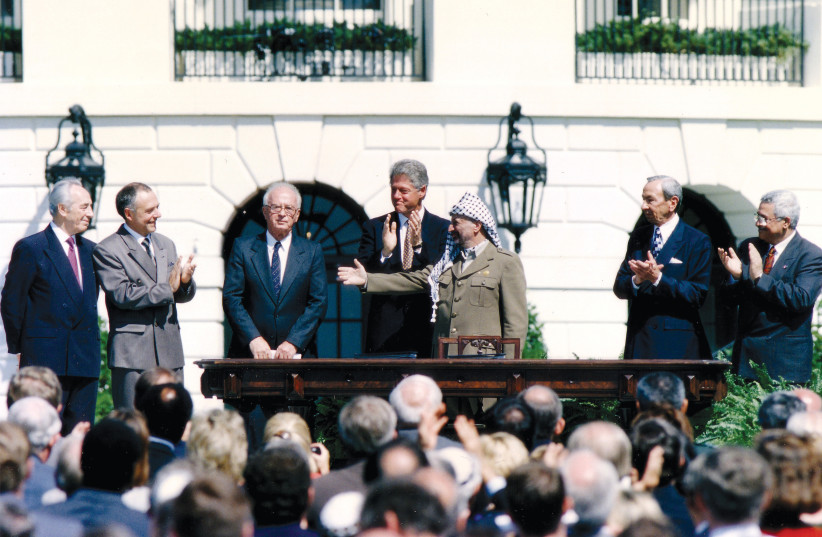
The “day after” concept for the Gaza Strip offers dreamers a brief window to design an optimal future for a small, 41-kilometer-long Mediterranean enclave sandwiched between Israel and Egypt.
After two decades, in which Gaza represented an unresolvable quagmire of periodic deadly violence, dangling a “day after” vision is almost like opening up a floodgate of possibilities.
For two-state solution supporters, it’s a moment to revive a peace process that would create a Palestinian state in Gaza linked to one in the West Bank, with borders based on the pre-1967 lines.
For those with a Greater Israel vision, it’s a moment to apply sovereignty to Gaza and find a relocation solution for most of the 2.3 million Palestinians living there, while replacing the enclave’s Arab cities and towns with Jews.
There are those for whom it is tempting to use the day after the Israel-Hamas war as an opportunity to travel back in time to erase perceived policy mistakes that set Israelis and Palestinians on the road to the October 7 attack.

For some on the Right, it means turning the clock back to the early 1990s, before the 1993 Oslo Accords allowed for the return of the PLO to Gaza and mandated the IDF withdrawal from its Palestinian cities.
Or they would take Israel only two decades back to the time before the 2005 IDF withdrawal from Gaza, destroying 21 settlements there under the Disengagement Plan.
The United States and some on the Left want to reset the clock to the start of January 2006, when the Palestinian Authority briefly ruled Gaza after the Israel withdrawal. It was before Hamas won an election that year and then forcibly seized control of the Strip in 2007.
For two-state supporters, 2006 was an optimal springboard moment, one in which neither settlements nor Hamas presented stumbling blocks for a Palestinian statehood.
But time travel only works in science fiction novels. In the very real present, neither two-state nor Israeli sovereignty supporters are likely to realize their visions in 2024.
Why is Israel isn't ready to consider a "day after" scenario for Gaza
That’s because Israel is very far from reaching the point of a “day after” scenario. It is preparing instead to navigate a vast chasm of chaos, which stretches from the Gaza quagmire that existed on October 6, across a post-October 7 one, that will mostly certainly replace it in 2024 and end only when a situation exists that allows for permanent “day after” plans to be executed for the enclave.
PRIME MINISTER Benjamin Netanyahu has stated that his goals for Gaza are to ensure that the people living there can never threaten Israel. To accomplish this goal, he plans to destroy Hamas; retain Israel’s security control; and prevent Palestinian Authority governance of the enclave, given its financial support for terrorists jailed by Israel for attacks against its citizens.
Short of explaining that the IDF must retain control of Gaza’s security and speaking loosely of a newly created Palestinian entity to rule the Strip, he has yet to put forward any tangible public proposal on the matter, even one that covers the new interim period Israel entered already in January 2024.
This new interim period will, by necessity, be marked by Israeli military control of Gaza. In past wars, the IDF entered and withdrew. It depended unsuccessfully on the damage done to Hamas’s infrastructure to act as a deterrent against future violence.
The Hamas-led October 7 massacre on Israel’s southern border, in which over 1,200 people were killed and some 250 taken hostage, has made an IDF withdrawal untenable in many Israeli eyes.
This time, the IDF is expected to remain in some capacity unless a suitable international military option is provided., At this stage, that seems unlikely.
Past Gaza wars had a clear start and end time. This one has not yet ended. It is transitioning from a high-intensity conflict to a low-intensity one, a situation that top IDF and Israeli officials have said could last for months.
Moving forward, Israel will need not one, but two transitionary plans for Gaza before it can even begin the more hotly debated proposal about a permanent future for the Gaza Strip, otherwise known as a Day After plan.
In the first phase of this interim period and the one most fraught with danger, an immediate governance solution must be found for Gaza that does not include Hamas. This must take place, even as Hamas still exists in the enclave and is engaged in battle with the IDF.
Even a temporary ceasefire, such as the kind reached through a hostage deal, would involve a scenario in which both the IDF and Hamas remain in Gaza, but without a governance structure.
The only body that could step in would be the Palestinian Authority, an idea Israel has rejected. A newly created Palestinian Authority that can rule the enclave is far from being formed and would be irrelevant as long as Hamas is in the Strip.
An ad hoc combination of local Palestinians with an international coalition with representation from the United States, the United Nations, and moderate Arab states is one option to fill the gap, even informally.
It will likely be cumbersome and inefficient due to challenges presented by the impact of the IDF’s military campaign, which has displaced most of the Gazan population. The military campaign has also destroyed the basic structure by which daily life occurs, such as the distribution of goods, basic services, and utilities.
The low-level war will likely mean that many Palestinians can still not return home; and if they do, those structures that are still standing are likely to be uninhabitable.
Even a well-organized, long-standing government would be tested by such a situation.
ONLY AN end to the Gaza war and the explicit defeat of Hamas would allow for a transition to a second phase or quagmire situation. Governance issues would be eased as a reconstruction phase began and homelessness lessened. Such governance would still be temporary and coupled with IDF action to prevent other terror groups from gaining ground in Gaza.
The sustained chaos of those two scenarios, neither of which is likely to have specific end dates, would probably occur amid a continued heated debate within Israel about what is next for Gaza.
It will take place concurrent with a debate between Israel and the international community, which will create tensions between a Netanyahu-led government that includes members who want to build settlements there, and an international community that wants to use this crisis as a springboard for a Palestinian state.
The friction will occur as the International Court of Justice adjudicates two cases that could impact Israel’s right to self-defense and freedom of action against Palestinian terror. The interim phases will also play out in what is an election year for US President Joe Biden, who will need to show strong support for Palestinian statehood with his electorate. They will also occur against the backdrop of what could be an election year for Netanyahu, who will need to lean toward his right-wing base that seeks Israeli sovereignty.
This all assumes that the Gaza conflict itself is not influenced by a possible war in Israel’s north against Hezbollah and a larger conflict with Iran.
The debate on Gaza often makes it sound as if the “day after” could start tomorrow. In reality, Israel remains in an extended period of chaos in Gaza, with no clear road map as to how it even gets to the “day after” for the long-troubled enclave.
